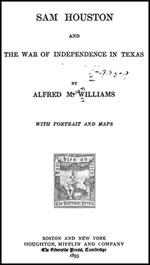May 21, 2015 - A good number of books on Texas History were written in the 19th century, some even before the State of Texas became a reality. Those writers were living during the time about which they were writing or, at least, shortly afterward. In these books is found valuable and first-hand information, sometimes conflicting with what more modern writers report as fact.
 Such is the case with an 1893 book by Alfred M. Williams, “Sam Houston and the War of Independence in Texas.” It documents the initial name of the village of Shelbyville—Tanaha, with a population of 100—which I had already discovered in rare 19th-century maps and reported in an earlier article. Our various “official” histories, commonly reported in pamphlets, web sites and articles, miss that interesting fact. Perhaps that is because there was at the same time a district of Tanaha and a present but entirely different town named Tenaha. Below is that particular passage from the Williams book of 1893.
Such is the case with an 1893 book by Alfred M. Williams, “Sam Houston and the War of Independence in Texas.” It documents the initial name of the village of Shelbyville—Tanaha, with a population of 100—which I had already discovered in rare 19th-century maps and reported in an earlier article. Our various “official” histories, commonly reported in pamphlets, web sites and articles, miss that interesting fact. Perhaps that is because there was at the same time a district of Tanaha and a present but entirely different town named Tenaha. Below is that particular passage from the Williams book of 1893.
“In 1834 Col. Juan Almonte, by the direction of the Mexican Government, made a tour of inspection through Texas, to report its population, trade, and general condition….He estimated the total population of Texas at 36,300, of which 15,300 were Indians.
“Texas at that time was divided into three departments—Bexar, Brazos, and Nacogdoches…. The total population of Nacogdoches, the eastern department, was 9900. It had four municipalities, with the population as follows: Nacogdoches, 3500; San Augustine, 2500; Liberty, 1000; Johnsbury, 1000. The town of Anahuac had a population of 50; Bevil, 140; Tanaha, 100; Teran, 10.”
While I continue to use 20th century sources as needed, I am more inclined to seek primary sources that record events during or near the time they are happening. In some cases, time and poetic license have led to a distorted history of our county. Unfortunately, the initial name of the village of Shelbyville is not the only case in question. More findings from history books written in the 19th-century will be reported in future issues of We the People of Shelby County (www.shelbycountytx.com).









